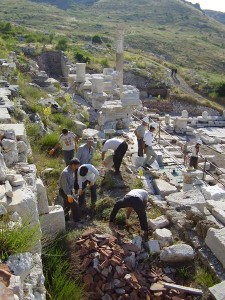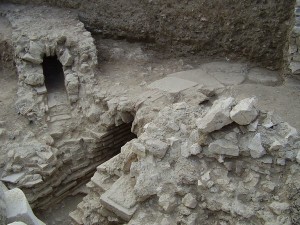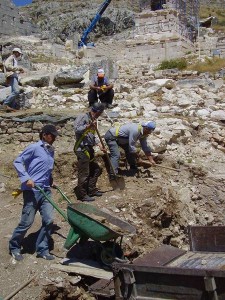 Over the last three weeks, the archaeological visual enhancement team has been working on three different locations around the Upper Agora of Sagalassos.
Over the last three weeks, the archaeological visual enhancement team has been working on three different locations around the Upper Agora of Sagalassos.
The first two weeks we were cleaning up the area immediately behind the Antonine Nymphaeum, in order to re-enact our archaeological understanding of the area upon finishing the excavations in the late 1990s, and allow for final plans to be drawn up for the provisioning of water to the Antonine Nymphaeum, as well as protect the backside of the building from water damage.
 This circa 40 by 4 meter area consisted of 4 rooms which can be related to the cellars/storage spaces of the early Byzantine market building on the terrace above it (site UAN) or with the water infrastructure works that supplied the Nymphaeum. Although this area was already excavated in 1994, 1995 and 1997 some new observations could be made, such as the discovery of a new water channel made from bricks and a mortared top of rubble and spolia, with an opening of 40 by 45 cm. This channel, flowing from the NW, connected into the already known water channel, about one meter behind the central niche of the Nymphaeum. The latter channel was opened up again and we were able to trace it for circa 20 meters towards the east as it runs immediately underneath the northern terrace wall. The aim of this cleaning operation was to establish whether in the future this channel can be used to provision the Antonine Nymphaeum with sparkling fresh water. A maintenance entrance to access the channel, built into the northern terrace wall, was discovered, while doing this. We were able to crawl into the channel for about nine meters as it is big enough for a person to enter. Funnily enough, we could make great use of a toy truck to remove the fill inside the water channel. Unfortunately, we were not able to do this completely as we reached a part where the roofing had collapsed and it was considered unsafe to continue.
This circa 40 by 4 meter area consisted of 4 rooms which can be related to the cellars/storage spaces of the early Byzantine market building on the terrace above it (site UAN) or with the water infrastructure works that supplied the Nymphaeum. Although this area was already excavated in 1994, 1995 and 1997 some new observations could be made, such as the discovery of a new water channel made from bricks and a mortared top of rubble and spolia, with an opening of 40 by 45 cm. This channel, flowing from the NW, connected into the already known water channel, about one meter behind the central niche of the Nymphaeum. The latter channel was opened up again and we were able to trace it for circa 20 meters towards the east as it runs immediately underneath the northern terrace wall. The aim of this cleaning operation was to establish whether in the future this channel can be used to provision the Antonine Nymphaeum with sparkling fresh water. A maintenance entrance to access the channel, built into the northern terrace wall, was discovered, while doing this. We were able to crawl into the channel for about nine meters as it is big enough for a person to enter. Funnily enough, we could make great use of a toy truck to remove the fill inside the water channel. Unfortunately, we were not able to do this completely as we reached a part where the roofing had collapsed and it was considered unsafe to continue.
 We continued to excavate in the most eastern room in the hope of finding strata associated with the building of the Hellenistic Market Building underneath. When executing this sondage, a hollow space was reached. Once inside, it became clear that several things had happened here. In fact, we had found another water channel, the floor and side wall of which had collapsed into a room of the Hellenistic Market Building. This room was for the most part filled up with soil and debris. For safety and logistical reasons it was decided not to excavate here. The function of this vaulted subterranean space remains unclear, as also no access to the space could be established.
We continued to excavate in the most eastern room in the hope of finding strata associated with the building of the Hellenistic Market Building underneath. When executing this sondage, a hollow space was reached. Once inside, it became clear that several things had happened here. In fact, we had found another water channel, the floor and side wall of which had collapsed into a room of the Hellenistic Market Building. This room was for the most part filled up with soil and debris. For safety and logistical reasons it was decided not to excavate here. The function of this vaulted subterranean space remains unclear, as also no access to the space could be established.
 We started the third week with excavating a portion of the water channel that runs north to south underneath the eastern side of the Upper Agora, with the aim of establishing whether this channel can be used in future for the evacuation of excess water from the Nymphaeum. Therefore, the section immediately east of the Nypmhaeum was investigated. Apart from establishing its structural condition, we wanted to see if we could date the various phases of this channel. Upon removal of one of its floor stones we found a couple of imperial body sherds, which post-date the first century AD, and are most probably to be associated with the building of the Antonine Nymphaeum. In this way, this northernmost section of the channel could be associated with the building project of the Nymphaeum and connected into a possibly older water channel that flew underneath the ancient NE street into the Upper Agora and continued underneath the latter’s eastern side. The lay-out of this older channel possibly goes back to the origin of the paved Upper Agora. Other than that, we could also establish that the fill contained inside the portion we cleaned is datable to the seventh century AD, indicating when the channel was no longer maintained. No doubt, such important water evacuation systems will have seen continuous maintenance and multiple repair phases. The last one of these consisted of providing this portion of the channel, as well as part of the connecting channel with a new cover of spoliated materials from the surroundings buildings. This operation can be associated with the beaten earth floor levels which were excavated last year in this corner of the Upper Agora, and were datable to the Early Byzantine period. These floor levels contained a series of terracotta water pipes, indicating the efforts to capture and manage water resources in the final days of Sagalassos.
We started the third week with excavating a portion of the water channel that runs north to south underneath the eastern side of the Upper Agora, with the aim of establishing whether this channel can be used in future for the evacuation of excess water from the Nymphaeum. Therefore, the section immediately east of the Nypmhaeum was investigated. Apart from establishing its structural condition, we wanted to see if we could date the various phases of this channel. Upon removal of one of its floor stones we found a couple of imperial body sherds, which post-date the first century AD, and are most probably to be associated with the building of the Antonine Nymphaeum. In this way, this northernmost section of the channel could be associated with the building project of the Nymphaeum and connected into a possibly older water channel that flew underneath the ancient NE street into the Upper Agora and continued underneath the latter’s eastern side. The lay-out of this older channel possibly goes back to the origin of the paved Upper Agora. Other than that, we could also establish that the fill contained inside the portion we cleaned is datable to the seventh century AD, indicating when the channel was no longer maintained. No doubt, such important water evacuation systems will have seen continuous maintenance and multiple repair phases. The last one of these consisted of providing this portion of the channel, as well as part of the connecting channel with a new cover of spoliated materials from the surroundings buildings. This operation can be associated with the beaten earth floor levels which were excavated last year in this corner of the Upper Agora, and were datable to the Early Byzantine period. These floor levels contained a series of terracotta water pipes, indicating the efforts to capture and manage water resources in the final days of Sagalassos.

